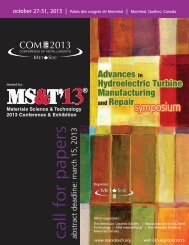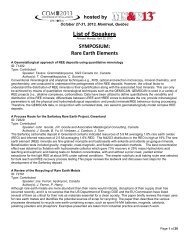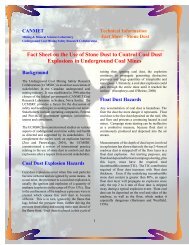List of Speakers SYMPOSIUM: Light Metals for Transportation
List of Speakers SYMPOSIUM: Light Metals for Transportation
List of Speakers SYMPOSIUM: Light Metals for Transportation
Create successful ePaper yourself
Turn your PDF publications into a flip-book with our unique Google optimized e-Paper software.
hosted byOctober 27-31, 2013, Montreal, Quebec<strong>List</strong> <strong>of</strong> <strong>Speakers</strong>Revised: Monday, April 22, 2013<strong>SYMPOSIUM</strong>:<strong>Light</strong> <strong>Metals</strong> <strong>for</strong> <strong>Transportation</strong>Significant ef<strong>for</strong>ts have been made by materials scientists and metallurgists to understand the underlying physics involvedin solidification <strong>of</strong> aluminum alloys to predict shrinkage porosities. Very few previous models <strong>for</strong> shrinkage predictionconsider the pore <strong>for</strong>mation based on a nucleation and growth basis. The objective <strong>of</strong> this study was to develop acomprehensive model that can predict shrinkage porosities that are <strong>for</strong>ming during solidification <strong>of</strong> A356 castings. Themodel utilizes a stochastic approach and takes into consideration the Niyama criterion as well as the nucleation potential<strong>for</strong> <strong>for</strong>mation <strong>of</strong> pores. There<strong>for</strong>e, it can predict the random nature <strong>of</strong> pore <strong>for</strong>mation during casting solidification.Correlations between the predictions and the pore amount were developed. For this model, literature validation wasprovided <strong>for</strong> an A356 alloy plate casting. Further validation was per<strong>for</strong>med <strong>for</strong> a bar geometry cast in a silica sand mold.The model predictions match reasonably well with the experimental measurements.Mechanical Strength at the Interface <strong>of</strong> a Steel Insert Embedded in an Aluminium Permanent Mold CastingID: 68622Type: ContributedSpeaker: Franco Chiesa, Centre de Métallurgie du Québec (CMQ), CanadaAuthor(s): F. Chiesa, J. Grenier, N. Giguère, F. LanicotAn aluminium skate-board truck including two steel inserts was poured in a permanent mold and the metallurgicalcharacteristics at the interface were investigated. No chemical interaction between the aluminium near-eutectic AlSi13alloy and the steel rods was observed. The mechanical adherence at the aluminium-steel interface was measured <strong>for</strong>insert preheating temperatures <strong>of</strong> 150°C and 350°C. Preheating the insert to a higher temperature was found to enhancethe adherence <strong>of</strong> the aluminium casting to the steel insert. By modeling filling and solidification, it was possible todetermine the thermal conditions all along the interface. It was found that the adherence increased from 6 to 14 MPawhen the local solidification time at the interface increased from 3s to 15s.Meso-mechanical Modelling on Ridging or Roping <strong>of</strong> Aluminium AlloysID: 70964Type: StudentSpeaker: Ling Qin, KU Leuven, BelgiumAuthor(s): L. Qin, M. Seefeldt, P. Van HoutteAluminium alloys <strong>for</strong> automobile body panel application <strong>of</strong>ten show a specific type <strong>of</strong> band-shaped surface rougheningupon stretching, called “ridging” or “roping”. Extensive research has indicated that the evolving surface roughness pr<strong>of</strong>ilesare related to surface texture patterning. This work presents a ‘Moving window’ method <strong>for</strong> detecting such texturepatterning based on EBSD orientation maps. The measured EBSD map can be subdivided by the moving window, withinwhich the orientation in<strong>for</strong>mation is selected to represent the local texture. Then, the full constraint Taylor crystal plasticitymodel is used to simulate the Lank<strong>for</strong>d coefficient (also called r-value) based on texture. By varying the size <strong>of</strong> the movingwindow in the transverse direction, the texture patterning in terms <strong>of</strong> the Lank<strong>for</strong>d coefficient can be studied. Two sampleswith different roping tendency are studied in this work.Microstructure and Natural Hardening <strong>of</strong> AlMg5Si2Mn Casting AlloyID: 70977Type: ContributedSpeaker: Kostiantyn Mykhalenkov, National Technical University <strong>of</strong> Ukraine "KPI", UkraineAuthor(s): K. Mykhalenkov, V. Boyko, T. Link, N. KorzhovaThe as-cast and heat treated structure <strong>of</strong> permanent mould and high pressure die castings <strong>of</strong> the AlMg5Si2Mn alloy hasbeen investigated by differential scanning calorimetry, microhardness measurements, transmission electron microscopyand energy dispersive X-ray analysis. Inside the a-Al grains curved plate-like precipitates were detected <strong>for</strong> both alloys.Page 9 <strong>of</strong> 17




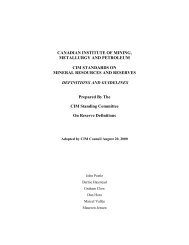
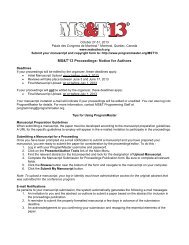


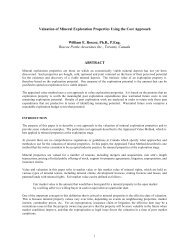
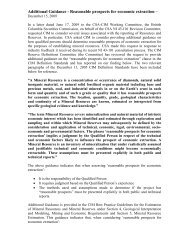
![Richard Wright - NORWEST Corporation [PDF]](https://img.yumpu.com/34320526/1/190x245/richard-wright-norwest-corporation-pdf.jpg?quality=85)
